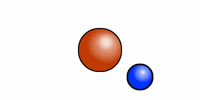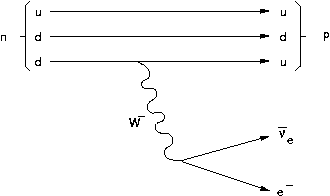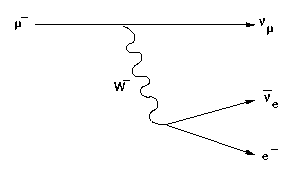
Physics goals - The Standard Model of Particles Physics
|
|
|
|
|
|
|
Introduction
One aim of Physics is to understand what is matter? How can it be created, transformed and eventually destroyed? How interact its components with each other? Since the end of the 19th century, we have known that matter is made of individual components: atoms. More than one hundred different kind of atoms (atomic elements) have been discovered. Atoms are small particles of matter, their size is typically about 10-10 m. Atomic elements have different masses, the lighter being the hydrogen. They have different electromagnetic properties that enable the assembling of several atoms in more complex structures: molecules and cristals. Depending on the local conditions, matter can exist in different atomic or molecular states: solid, liquid, gaseous, plasma. As far as we know, observed (visible) matter in the universe is almost exclusively made of the hydrogen (H) and helium (He) elements while other elements (C,N,O,Si,Fe...) are present only as trace (not on the Earth of course!).
Scientists have understood quite early - thanks to experimental results - that atoms where composite particles and that something else exists at a more fondamental level and smaller scales. They discovered that the atom was made of a central nucleus with a positive electric charge while electrons orbit around it. The study of the atomic nucleus gave birth to nuclear physics. Figure 1 shows the naive representation of a hydrogen atom where electric forces play a fundamental role. The atomic nucleus is made of one single proton (brown ball) with an electron (blue ball) spinning around. Protons and electrons are particles of matter, while exchanged photons (yellow light) between the proton and the electron are the messengers of the electromagnetic interaction that makes the atom a stable object (at low temperature only!).

|
The Standard Model of Particle Physics
The Standard Model of Particle Physics (SM) is a theoretical framework that scientists involved in high energy physics (HEP) have elaborated during the last 70 years thanks to a huge amount of experimental and theoretical efforts. The SM is not an exact theory. It does not allow us to understand and predict everything that may happen in the subatomic real world. Nevertheless the SM has met considerable success over years, making some aspects of the known fundamental interactions and the compositeness of matter understandable, predicting the existence of new particles and explaining new processes at the subatomic scales but also in cosmology and astrophysics.
The SM is still not complete (will it ever be?). In its present minimal form, it cannot answer some fundamental questions:
- What gives a mass to elementary particles?
This is the aim of intensive research of the Higgs particle at CERN (LHC). - What can explain the observed tiny asymmetry
between mater and antimatter at subatomic scales?
It is believed that the observed universe (yes, the place we live in!) still exists thanks to this asymmetry... - Are the known elementary particles
really elementary?
Up to now, we never succeed in breaking an electron into smaller parts! - Do other unknown elementary particles exist?
Some HEP physicists search for new super-symmetric particles... - Does a more complete theory exist, including all aspects of subatomic physics and also the gravitational interaction?
The answer to these questions can only come thanks to new experimental and theoretical work.
Fundamental interactions
Physicists have discovered four fundamental interactions:
- The electromagnetic interaction (EMI) is responsible of well known phenomenons such as electricity and magnetism.
- The strong interaction (SI) is the most intense known interaction; it allows the stability of the atomic nucleus preventing its dissociation due to electric repulsive forces.
- The weak interaction (WI) is a far less intense interaction that is responsible of some specific processes, such as the nuclear beta decay, thermonuclear fusion in the Sun's core, playing a fondamental role in the explosion of (super)novae...
- The gravitationnal interaction (gravity) is considered to have no influence at the subatomic level... but its role is crucial at large scales (astrophysics). No theory of gravity is included in the framework of the SM.
All fundamental interactions obey some special rules, i.e. they follow (or violate) some fundamental symmetries and conservation laws. Some well known conservation laws are:
- conservation of the energy and momentum: for example, one cannot create a particle of mass M from an total amount of available energy less than E=M c2 (c is the speed of light in vacuum). A proton (mp = 938.27 MeV/c2) cannot decay into a neutron (mn = 939.56 MeV/c2) for its energy of mass is not high enough.
- conservation of the electrical charge: as far as we know, a single electron cannot transform into a positron (see section Leptons in this page),
- conservation of the angular momentum...
Other conservation rules exist...
It is now well established that the electromagnetic and the weak interactions are two different aspects of the same fundamental interaction (the electroweak theory). More, physicists believe that all interactions come from a same fundamental process at the early beginning of the universe. HEP physics aims to find the way to unify all processes and objects observed in our universe in a unique (simple?) theroretical framework.
Elementary particles
The SM proposes a classification of elementary particles that is based on fundamental symmetries. We know two families of particles: bosons and fermions. More, to each known particle corresponds an anti-particle with the same mass, lifetime and opposite electrical charge (matter/antimatter symmetry). Particles interact with each other thanks to fundamental interactions.
Bosons are the messenger particles of the four fundamental interactions (electromagnetic/weak, strong and gravitational interactions). For example the well known massless photon (γ) is the messenger of the electromagnetic interaction. The bosons W+, W- and Z0 are the massive messengers of the weak interaction (beta decay in atomic nucleus, muon decay...). The gluon (g) has never been observed experimentally but it is believed that it is the messenger of the strong interaction.
Quarks
Fermions are the particles from which the matter is made of. This family consists in two groups of elementary particles: quarks (q is a general symbol) and leptons (l is a general symbol). No free quark has never been directly observed up to now. Nevertheless we believe from the analysis of many HEP experiments that six different quarks exist together with six corresponding anti-particles (anti-quarks, see table 1). These quarks are labelled up (u), down (d), strange (s), charm (c), bottom (b) and top (t).
Table 1: the quarks family (data from the Particle Data group, colors convention for the small images is arbitrary). Iz is the isospin charge, C is the Charm number, S is the Strangeness number, B is the Bottom/Beauty number, T is the Top number. |
In addition to the specific numbers associated to them (Iz,S,C,B,T), all quarks have a special quantum number named the baryonic number: its value is +1/3 for quarks and -1/3 for anti-quarks. Quarks are sensitive to all known fundamental interactions.
Physicists believe that nucleons (neutron: n , proton: p ) - which are the components of the atomic nucleus - are made of quarks (figure 2). Other hundreds of observed composite particles are also made of quarks (hadrons). Baryons are hadrons made of 3 quarks and mesons are hadrons made of a quark and an anti-quark.
| Proton | Neutron |
 |
 |
Leptons
In the Standard Model of elementary particles, leptons are spin 1/2 fundamental particles that interact only through electro-weak processes (and gravity). Up to now, physicists have discovered/observed six different leptons together with their six associated anti-particles. Table 1 shows the main properties of the six charged leptons (electrons...) and the six neutral leptons (neutrinos and anti-neutrinos).
Table 2: the leptons family (data from the Particle Data group). Le,μ,τ are the flavored leptonic numbers. |
One distinguishes three different leptonic numbers, one for each neutrino flavor:
- the electron leptonic number: Le,
- the muon leptonic number: Lμ,
- the tau leptonic number: Lτ.
As an example, have a look on the beta decay of the free neutron on figure 3:
 |

|
Within the SM framework, we can represent this weak interaction process at the elementary particles level as shown in figure 4:
 |
Figure 5 illustrates the muon decay process:
 |
 |
 |
Contents
|
Last update: 30-03-2004











